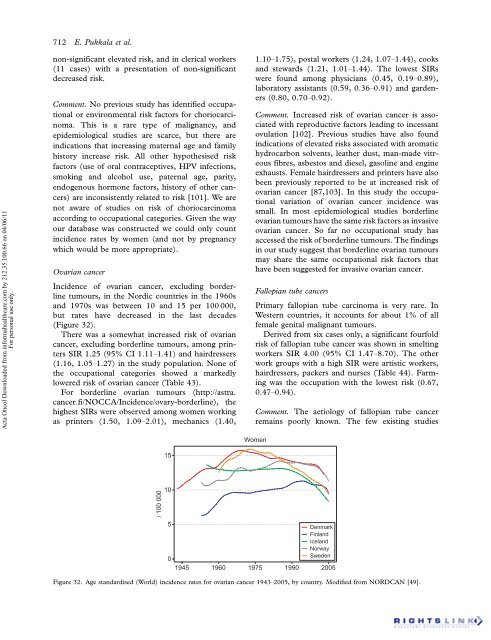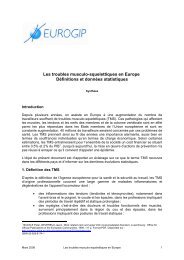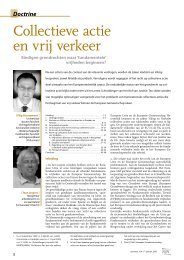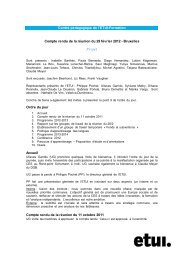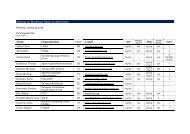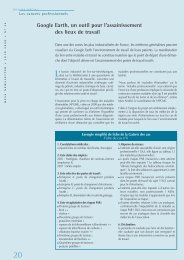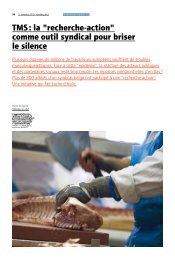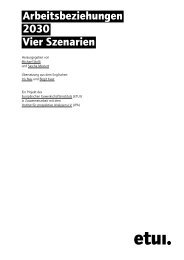Occupation and cancer - European Trade Union Institute (ETUI)
Occupation and cancer - European Trade Union Institute (ETUI)
Occupation and cancer - European Trade Union Institute (ETUI)
Create successful ePaper yourself
Turn your PDF publications into a flip-book with our unique Google optimized e-Paper software.
Acta Oncol Downloaded from informahealthcare.com by 212.35.100.66 on 04/06/11<br />
For personal use only.<br />
712 E. Pukkala et al.<br />
non-significant elevated risk, <strong>and</strong> in clerical workers<br />
(11 cases) with a presentation of non-significant<br />
decreased risk.<br />
Comment. No previous study has identified occupational<br />
or environmental risk factors for choriocarcinoma.<br />
This is a rare type of malignancy, <strong>and</strong><br />
epidemiological studies are scarce, but there are<br />
indications that increasing maternal age <strong>and</strong> family<br />
history increase risk. All other hypothesised risk<br />
factors (use of oral contraceptives, HPV infections,<br />
smoking <strong>and</strong> alcohol use, paternal age, parity,<br />
endogenous hormone factors, history of other <strong>cancer</strong>s)<br />
are inconsistently related to risk [101]. We are<br />
not aware of studies on risk of choriocarcinoma<br />
according to occupational categories. Given the way<br />
our database was constructed we could only count<br />
incidence rates by women (<strong>and</strong> not by pregnancy<br />
which would be more appropriate).<br />
Ovarian <strong>cancer</strong><br />
Incidence of ovarian <strong>cancer</strong>, excluding borderline<br />
tumours, in the Nordic countries in the 1960s<br />
<strong>and</strong> 1970s was between 10 <strong>and</strong> 15 per 100 000,<br />
but rates have decreased in the last decades<br />
(Figure 32).<br />
There was a somewhat increased risk of ovarian<br />
<strong>cancer</strong>, excluding borderline tumours, among printers<br />
SIR 1.25 (95% CI 1.11 1.41) <strong>and</strong> hairdressers<br />
(1.16, 1.05 1.27) in the study population. None of<br />
the occupational categories showed a markedly<br />
lowered risk of ovarian <strong>cancer</strong> (Table 43).<br />
For borderline ovarian tumours (http://astra.<br />
<strong>cancer</strong>.fi/NOCCA/Incidence/ovary-borderline), the<br />
highest SIRs were observed among women working<br />
as printers (1.50, 1.09 2.01), mechanics (1.40,<br />
/ 100 000<br />
15<br />
10<br />
5<br />
Denmark<br />
Finl<strong>and</strong><br />
Icel<strong>and</strong><br />
Norway<br />
0<br />
Sweden<br />
1945 1960 1975 1990 2005<br />
1.10 1.75), postal workers (1.24, 1.07 1.44), cooks<br />
<strong>and</strong> stewards (1.21, 1.01 1.44). The lowest SIRs<br />
were found among physicians (0.45, 0.19 0.89),<br />
laboratory assistants (0.59, 0.36 0.91) <strong>and</strong> gardeners<br />
(0.80, 0.70 0.92).<br />
Comment. Increased risk of ovarian <strong>cancer</strong> is associated<br />
with reproductive factors leading to incessant<br />
ovulation [102]. Previous studies have also found<br />
indications of elevated risks associated with aromatic<br />
hydrocarbon solvents, leather dust, man-made vitreous<br />
fibres, asbestos <strong>and</strong> diesel, gasoline <strong>and</strong> engine<br />
exhausts. Female hairdressers <strong>and</strong> printers have also<br />
been previously reported to be at increased risk of<br />
ovarian <strong>cancer</strong> [87,103]. In this study the occupational<br />
variation of ovarian <strong>cancer</strong> incidence was<br />
small. In most epidemiological studies borderline<br />
ovarian tumours have the same risk factors as invasive<br />
ovarian <strong>cancer</strong>. So far no occupational study has<br />
accessed the risk of borderline tumours. The findings<br />
in our study suggest that borderline ovarian tumours<br />
may share the same occupational risk factors that<br />
have been suggested for invasive ovarian <strong>cancer</strong>.<br />
Fallopian tube <strong>cancer</strong>s<br />
Primary fallopian tube carcinoma is very rare. In<br />
Western countries, it accounts for about 1% of all<br />
female genital malignant tumours.<br />
Derived from six cases only, a significant fourfold<br />
risk of fallopian tube <strong>cancer</strong> was shown in smelting<br />
workers SIR 4.00 (95% CI 1.47 8.70). The other<br />
work groups with a high SIR were artistic workers,<br />
hairdressers, packers <strong>and</strong> nurses (Table 44). Farming<br />
was the occupation with the lowest risk (0.67,<br />
0.47 0.94).<br />
Comment. The aetiology of fallopian tube <strong>cancer</strong><br />
remains poorly known. The few existing studies<br />
Women<br />
Figure 32. Age st<strong>and</strong>ardised (World) incidence rates for ovarian <strong>cancer</strong> 1943 2005, by country. Modified from NORDCAN [49].


